STRATEGY GUIDE
The dealer’s website playbook
Chapter 4: Turning browsers into buyers
Every visitor on your website represents a potential customer, and your ability to guide them from browsing to action directly impacts your bottom line. However, with over 62 digital touchpoints shaping each purchase journey1, buyers are spending more time researching and comparing online. To capture that attention, your site must reduce cognitive friction and deliver transparent, decision-ready clarity that builds trust and momentum.
When your website anticipates shopper uncertainty — clarifying pricing, simplifying options, and presenting next steps with minimal effort — you transform curiosity into commitment.
In this chapter, we’ll show you how to build content for your website that aims to:
- Enhance VDPs that guide shoppers through every decision point
- Present transparent pricing that establishes trust and speeds up conversion
- Create clear, streamlined CTAs that guide more visitors to convert using proven digital best practices
Be the answer to their questions on your VDP
Your Vehicle Detail Pages (VDPs) represent one of your highest-value conversion moments. When a shopper reaches a VDP, they’ve entered an intent-driven mindset — one where micro-decisions accumulate toward action. This is where design, messaging, and usability converge to reinforce confidence and remove hesitation.
Question 1: “Is this the right vehicle for me?”
Shoppers land on your VDP with a mental checklist. They want to see themselves in this vehicle, understand its capabilities, and quickly assess if it fits their specific situation. Give shoppers confidence that this car meets their needs. Your imagery and vehicle presentation must do the heavy lifting here.
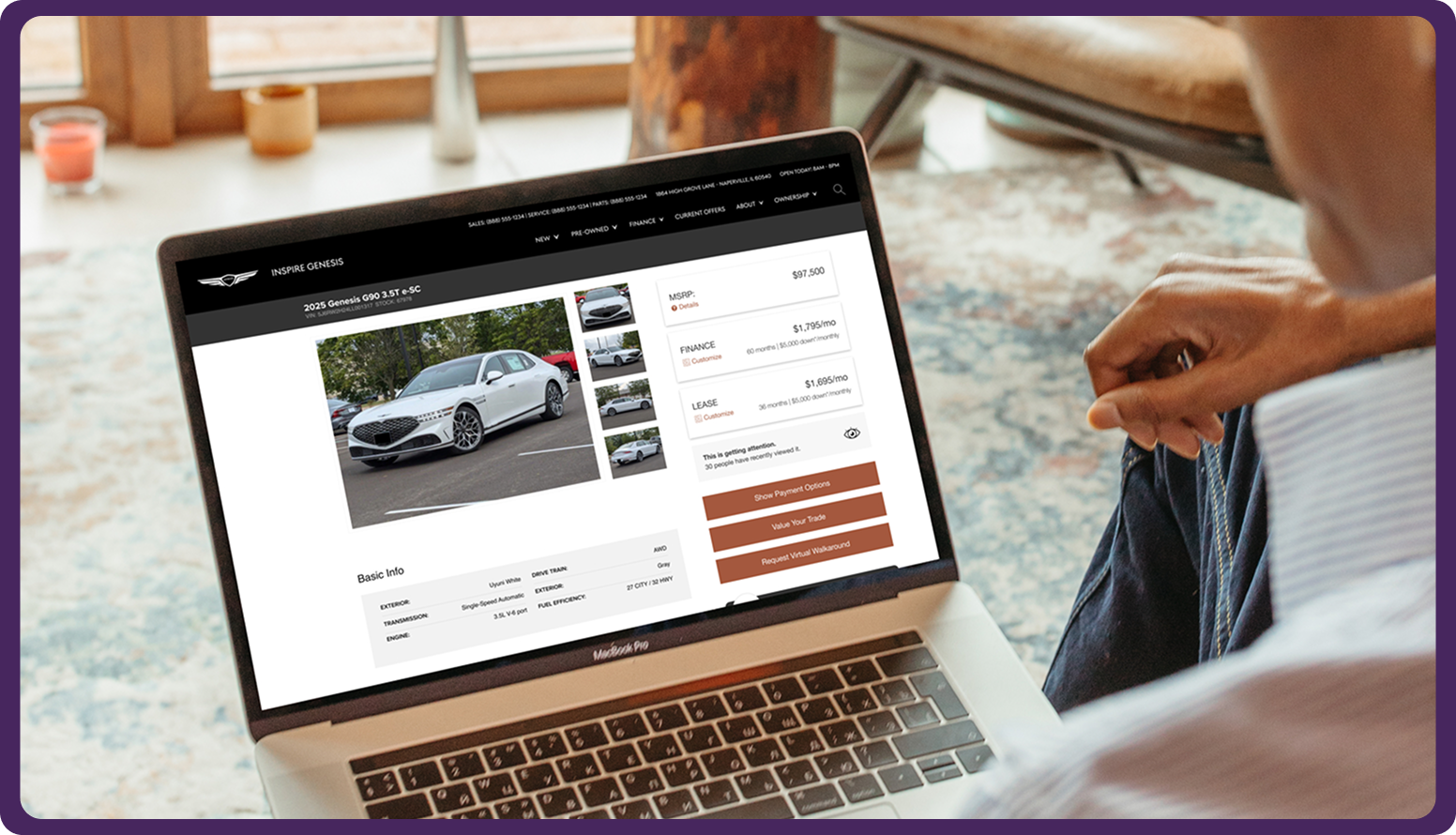
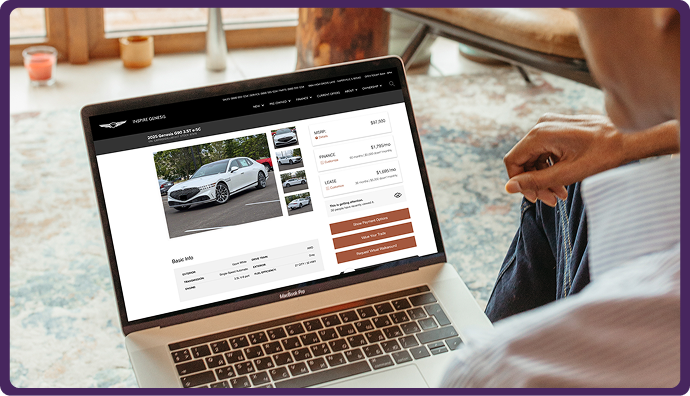
- Authentic photos: Go beyond minimum photo sets. Invest in clear, consistent photos from multiple angles that help shoppers feel confident they’re seeing the real vehicle — not just a stock placeholder. Sequence matters too: start with your strongest “hero” image, then move through exterior, interior, and detail shots in a logical flow that tells the car’s story.
- Essential details, clearly displayed: Every VDP lists specs, but how you present them can make or break engagement. Organize key info like trim, mileage, condition, and fuel economy in a clean, scannable layout. Highlight what matters most in your market — for example, AWD for winter states or EV range for urban buyers, so the details don’t just inform, they resonate
- Transparent condition descriptions: Shoppers want to trust what they’re seeing. Describe condition and reconditioning work in straightforward language that builds confidence. Instead of “minor scratches,” use phrasing like “professionally inspected with light cosmetic wear.” Proactive framing reduces skepticism and keeps buyers moving forward.

What shoppers need: Immediate visual confirmation that this vehicle matches their needs, lifestyle, and expectations.
Question 2: “Can I afford it?”
Price uncertainty continues to shape consumer purchase plans. In a recent survey, nearly 40% of consumers who had intended to buy a vehicle are postponing that purchase because of the belief of raised prices, while a quarter plan instead to purchase a more affordable car type2. This is due to shoppers navigating elevated interest rates, concerns about vehicle values, and uncertainty about trade equity. Your pricing presentation must eliminate confusion, build trust, and accelerate buying decisions. Here’s where your price transparency will drive action.
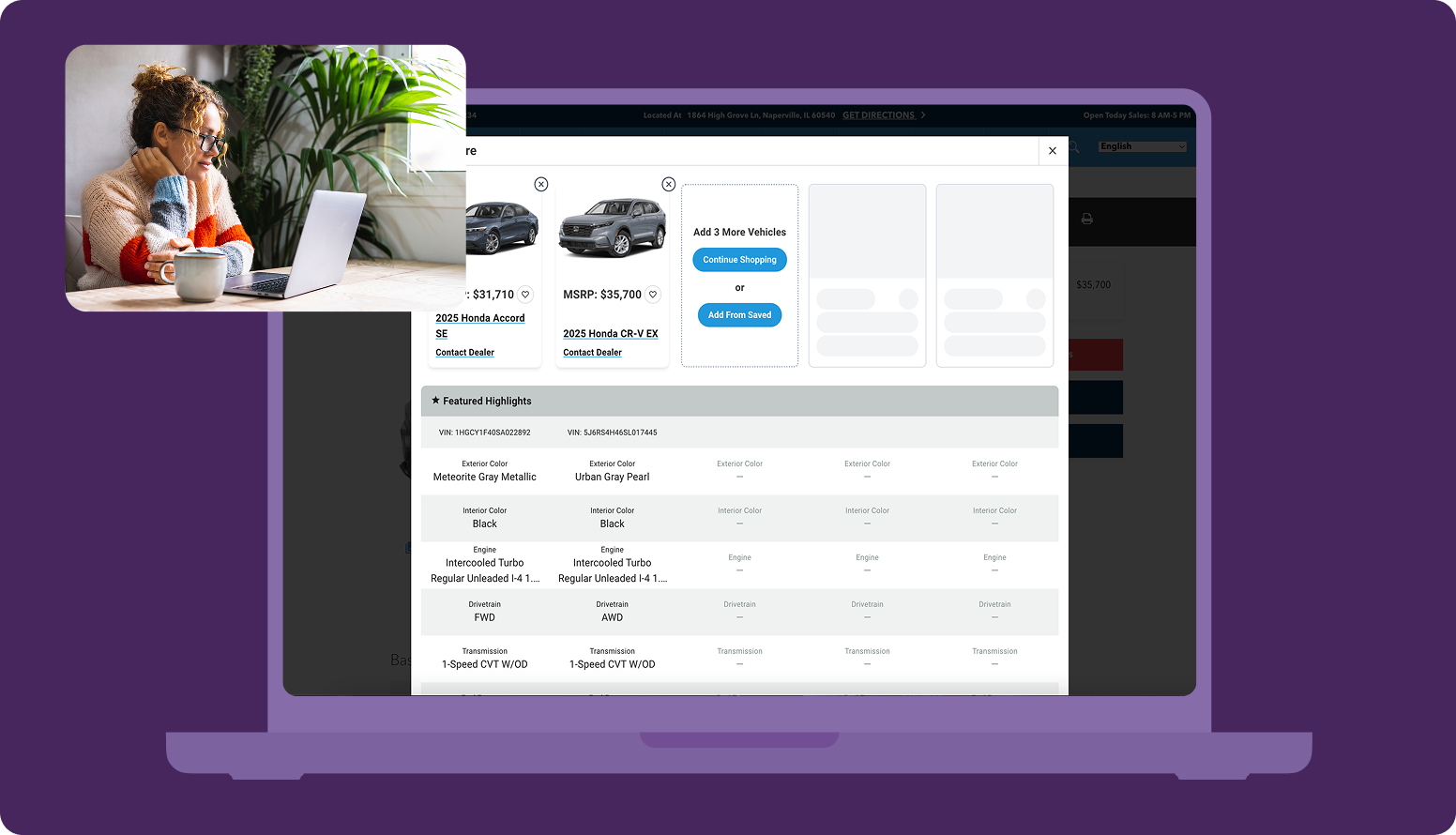

- Upfront pricing: Shoppers today will compare your price across multiple sources. The strategy isn’t just “show the number”, it’s about owning the narrative. Call out what’s included (warranties, service packages, delivery, etc.) so your transparency stands out against low-ball competitors who add surprise fees later.
- Current incentives: Offers and incentives work best when they’re visible at key decision points. Ensure they appear where shoppers are comparing payments (like your, VRPs. VDPs and payment calculators), rather than limiting them to a specials page. Reinforce urgency with clear, time-bound language at these touchpoints to encourage action before shoppers move on.
- Dynamic payment calculators: Don’t just drop in a calculator widget, tie it directly to your lenders so the numbers reflect real approval terms. When shoppers can see pre-qualified payments instead of rough estimates, they get a clearer path to affordability and your team avoids surprises later in the process.
- Trade-in tools: A generic trade range isn’t enough anymore. Use real-time appraisal data (AccuTrade integration, for example) to give instant, VIN-specific offers that carry through to the deal desk. The strategy here is consistency that builds confidence: the same number online, in the showroom, and in the service lane.

What shoppers need: Clear, transparent pricing with immediate understanding of monthly costs and trade-in impact.
Question 3: “Where should I buy my car?”
Trust is the foundation of every customer relationship. In today’s competitive marketplace, buyers are increasingly selective about where they spend money and who they choose to work with. Your dealership must immediately establish credibility and demonstrate a track record of positive customer experiences. Reputation seals the deal.
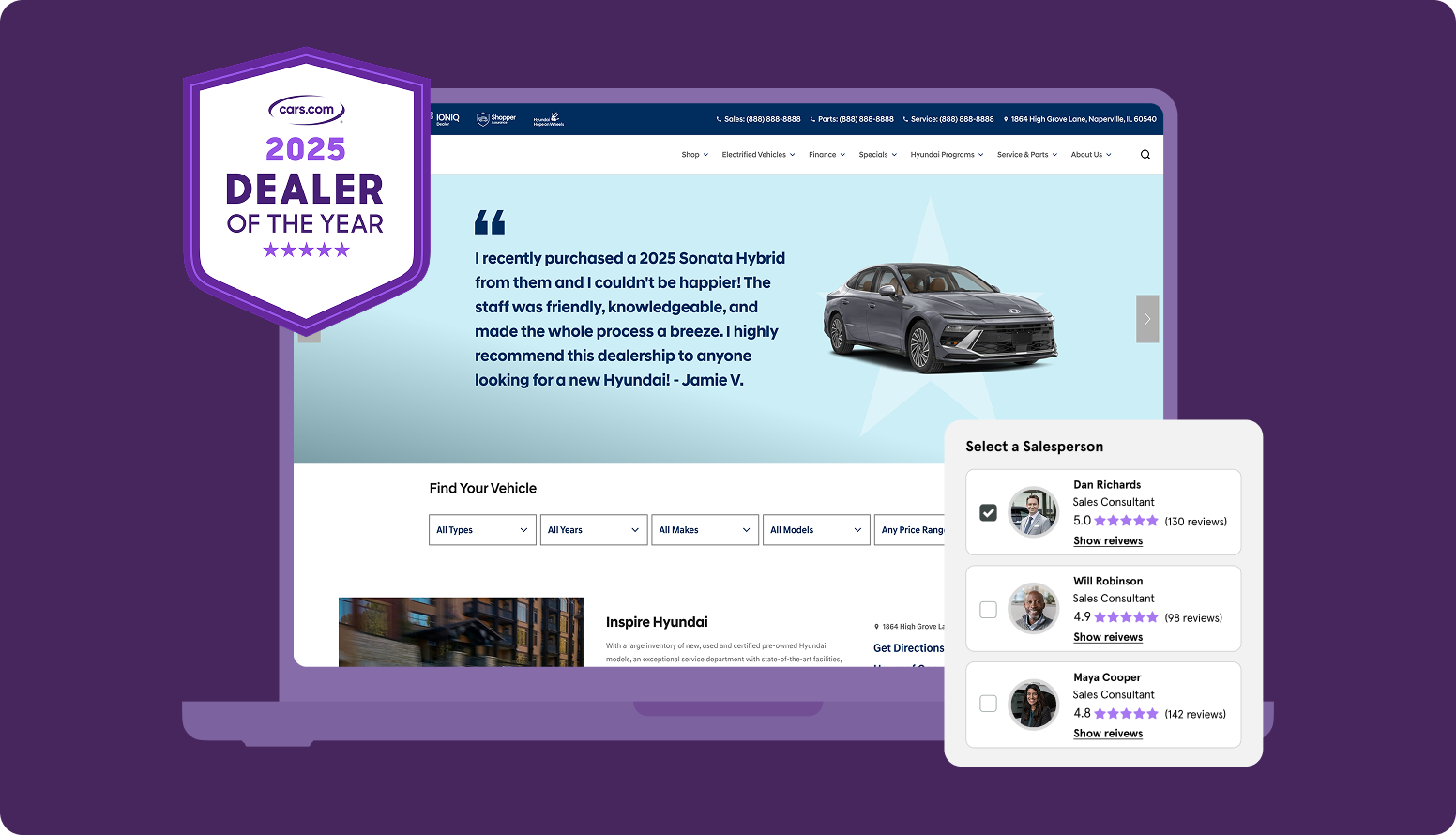
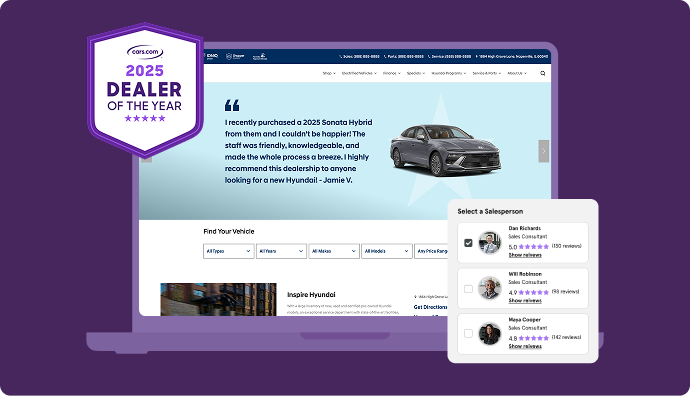
- Customer reviews: Reviews are powerful conversion tools, but only when shoppers actually see them. Instead of relegating testimonials to a separate page, integrate customer quotes directly into the VDP experience. Highlight verified dealership reviews that mention experiences like “fair pricing,” “transparent about vehicle condition,” or “easy financing process.” Place them right where shoppers are evaluating whether to take the next step — not just star ratings, but the details that build real confidence.
- Badges & certifications: While shoppers may skim written specs, they notice visual credibility markers. Prominently display key details like award badges, warranty coverages, or CPO program details on your VDPs and SRPs. Connect these trust signals to your dealership’s Why Buy messaging for added context and depth.
- Let them choose their team: You can turn shopper uncertainty about the sales process into an advantage. Letting shoppers choose their salesperson upfront creates comfort and reduces friction at the store. You can feature staff bios with specialties (ex: “EV expert,” “family car specialist”) so shoppers self-match with the rep most likely to close them.
- Transparent pricing: Show MSRP and your discounts together on every listing, highlight offers with simple visual cues, and add quick explanations where needed. This upfront approach eliminates the pricing games that make shoppers wary and positions your dealership as straightforward from the start.

What shoppers need: Social proof, credentials, and transparency that prove you’re a customer-focused business.
Question 4: “What’s my next step?”
Your VDPs are where interest turns into action, but only if you make the next step obvious and easy. Your CTAs must guide shoppers seamlessly toward completing a lead, appointment, or purchase — not overwhelm them with choices.
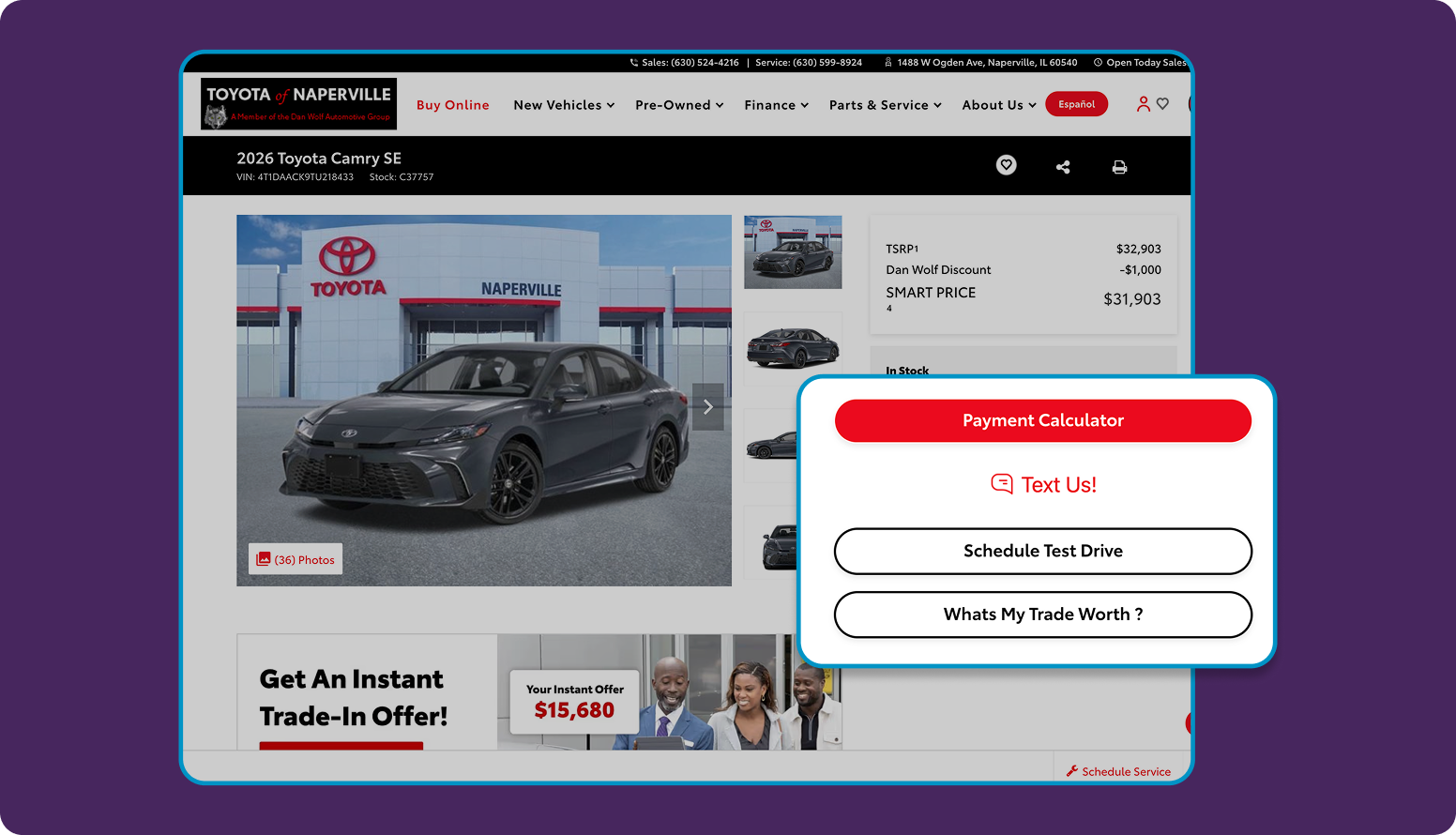

- Prioritize the primary conversion path: Identify the single most valuable action you want shoppers to take on your VDP, then make that your unmistakable primary CTA. This action should be the easiest to see on the page and represent the clearest next step in your sales process.
- Support with connected options: Secondary choices (like trade-in or financing) should flow naturally from the primary path. Don’t scatter attention with disconnected offers that can add more time that it takes for the customer to submit their lead.
- Reduce the options: Simplify the path to purchase by limiting the amount of CTAs and widgets. Dealers who simplified results pages by removing excess CTAs saw a +16% lift in conversion rate3. On the flip side, cluttered sites can run up to 3x slower and drive shoppers away4.
CTA effectiveness in automotive
To understand which calls-to-action truly move shoppers to click, Dealer Inspire analyzed more than a billion website impressions and millions of CTA interactions across 3,800 dealer sites.
The goal: identify the phrasing that best reduces hesitation and builds momentum toward a lead or sale.
Across every category, simple, action-first verbs outperformed longer or passive language — confirming that clarity and immediacy drive stronger engagement. When CTAs feel like a direct next step (“Get Today’s Price”) rather than an extra task (“Request Info”), shoppers act faster and with more confidence.
| Category | Top Performer | Secondary / Alternatives | Avoid | Key Takeaway |
|---|---|---|---|---|
| 💰 Price | Get Today’s Price | Reveal Price | Price Details, Price Info | Urgency and immediacy drive clicks, make it feel like a live offer. |
| 💳 Payment | Calculate Payments / Payment Calculator | See / Show Payment Options | Estimate Payments, Customize Payments | Shoppers prefer quick clarity, “calculate” feels simple and certain. |
| 🛒 Purchase | Buy Now | Start Buying Process, Start Purchase | Start My Purchase, Buy From Home | Decisive, confident verbs build trust and purchase intent. |
| 🚙 Test Drive | Book a Test Drive / Schedule a Test Drive | Reserve Test Drive | Request Test Drive | Firm, action-oriented wording converts curiosity into commitment. |
| 🔄 Trade-In | Text My Trade Value (SMS) / Value Your Trade (Web) | Get Trade Value | Estimate / Check Trade Value | Clear, conversational phrasing signals speed and simplicity. |
In short: decisive, outcome-oriented phrasing turns curiosity into clicks. The right words remove friction, reinforce trust, and keep shoppers moving forward.
What’s next: Chapter 5 – Retain & Recapture
Winning the sale is just the start. In Chapter 5, you’ll see how to turn post-sale interactions into lifetime value by applying the same friction-reduction and personalization principles to service and loyalty experiences.
We’ll cover how to:
- Build trust and convenience into your Service page with the right essentials.
- Unlock trade-in opportunities directly from your service lane.
- Keep customers engaged with offers, loyalty programs, and personalized experiences.
📄 Get the Quick Reference Guide
Download the condensed PDF version of Chapter 4 — packed with key takeaways and actionable tactics. Perfect for a quick study before your next strategy meeting.
Download the Quick GuideNot with Dealer Inspire?
See how our websites turn shopper intent into action with data-backed UX design, transparent pricing experiences, and conversion paths built to reduce friction and build trust at every click.
1 Clarivoy. Engaged-Buyer Internal Analysis. Columbus, OH: Clarivoy, 2024. Proprietary report.
2 Buresch, Natascha, et al. “Will Today’s Environment Affect Vehicle Purchase Decisions for US Consumers? | McKinsey.” Www.mckinsey.com
3 Cars Commerce Q2 2024 test results, GA4 data
4 Cars Commerce Q2 2024 test results, GA4 data